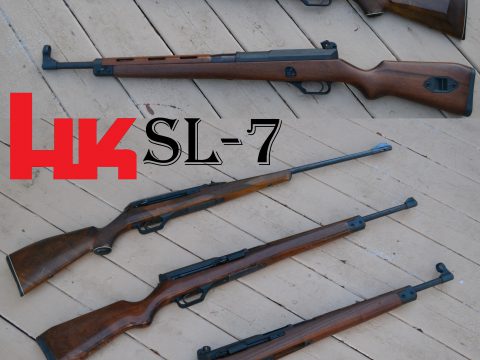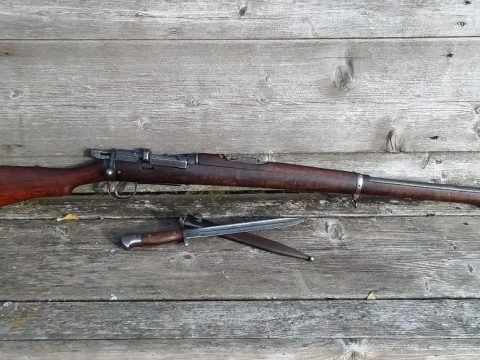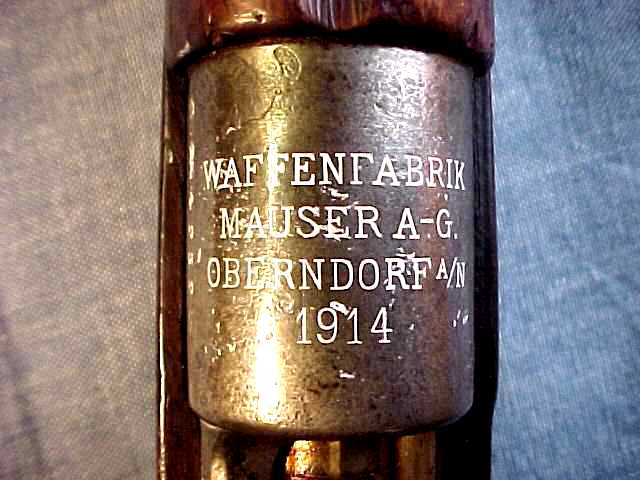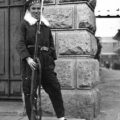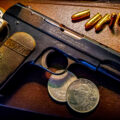As part of a larger research project into the possible use of the Mannlicher M.86 rifle in the Chilean Civil War of 1891 I came across an extraordinary claim: that it was this little known conflict, rather than the later Spanish-American war, that saw the first large scale martial use of rifles utilising cartridges loaded with smokeless powder.
What I discovered has provided a salutary lesson in the perils of believing claims made by inventors and that even the best general historians can make mistakes when it comes to the details of firearms history.
The Claim:
This can be found in a brief article in the “New York Times” dated September 6 1891 titled ‘Gelbite In Actual War’. The article says: ‘In the press dispatches from Chile it has been stated that the insurgent party used smokeless powder in their small arms.’ The same article went on the say that the powder, known as ‘Gelbite’ was an American invention and thus it was to American ingenuity that ‘…the honor belongs of being the first smokeless powder used in actual warfare’.(1) If true, this would represent a real milestone in the history of military firearms.
Supporting Evidence:
My initial research seemed to suggest that this claim may indeed have been true. The standard work in English on the Chilean Army during this period, ‘The Grand Illusion: The Prussianization of the Chilean Army’ clearly states that the rifle used by the congressionalists ‘fired smokeless bullets…’(2)
On the other hand:
However, the other evidence I’ve found shows that the Mannlicher M.88s fielded with such effect by the congressionalist ‘rebels’ were still using ammunition loaded with black powder. This evidence can be summarised as follows:
We know where the ammunition supplied to the rebels came from. Thanks to a comprehensive list of weapons and ammunition purchased by agents of the congressionalist party we know that the ammunition was supplied from Europe, not America; indeed collectors have claimed to have found well provenanced examples of Austrian manufactured black powder 8mm ammunition supplied to Chile dated 1891. (3)
Professional observers at the time didn’t mention the use of smokeless ammunition. One contemporary American military report stated that the conflict was of particular interest because the use of the Mannlicher M.88 represented the first time a ‘modern small-calibre’ (my emphasis) rifle had been used in battle. (4) This interest was echoed in another American report which said that this conflict was the one in which ‘small caliber repeating rifles had their first actual test under fire’. (5) Smokeless powder is not mentioned at all in either report, hardly something professional authors would ignore. On a more macabre note the American Rear Admiral George Brown, in his dispatch to the State department which described the chaotic end of the Balmaceda regime and the occupation of Valparaiso, reported that American surgeons had been sent ashore to help treat the wounded. He believed that they would return with useful military and medical intelligence because “many of the wounds will have been from the balls (sic) of the Mannlicher rifles of .302 caliber and of high power”.(6)
So what’s going on?
The first problem is that general historians who are focused more on the motivations and machinations that brought civil war and rifles to Chile may not know that much about the details of weapons technology. For example, earlier in the book cited the authors say, “The standard weapon of the German infantry after the Franco-Prussian War was the 7.9mm Gewehr 88 (Rifle 88) basically a refined version of the 11mm Austrian Mannlicher M86”. (7) Neither of these statements are accurate. The standard German weapons after the Franco-Prussian war were the single shot Mauser designed M.71, followed by the repeating M.71/84. Both were made in their millions so can’t just be ignored. Similarly, saying that the G.88 is a ‘refined’ M.86 is just wrong. It’s true that it uses a similar method of removing the bolt to the M.86 and an iteration of the Mannlicher ‘packet loading’ system but everything else about the rifle, from its bolt to its barrel are very different in conception and execution. This kind of fundamental error makes me doubt their earlier statement supporting the newspaper article.
The second problem is that sometimes journalists don’t check their sources, especially when they have a deadline to meet and a paper to fill. The New York Times report is actually more like ‘advertorial’ than careful reportage. It repeats without question the claim by a Dr Stephen Emmens, the American inventor of ‘Gelbite’ powder, that he provided the ammunition used during the war. Further examination makes me think the good doctor may not have been telling the whole truth. In particular, in the article Dr Emmens claimed that his powder was being tested by both the US Army and Navy and that it was likely that his invention would be used ‘extensively’ by them. That was partially true, but he neglected to mention the results of those tests. When the propellant was tested by the US Army at the Springfield Armoury in February 1890 to determine its suitability for military use it failed to measure up, either because of the composition of the substance itself or the way it was made up into cartridges. (8) Perhaps Dr Emmens was increasingly desperate to profit from his invention after its rejection by the US Army and decided to be less than honest about its success. After all, Chile was a long way away and who was likely to question his bold assertion passed on with such patriotic zeal by a newspaper keen to emphasise American success?
Conclusion:
To summarise. I don’t believe the original claim. I suspect that the claim by Dr Emmens as reported in the “New York Times” has a financial motive and is not backed up by other contemporary professional sources and that modern general historians have confused a ‘small bore’ rifle with one utilising ‘smokeless’ powder
My conclusion is that what might seem like pointless detail matters because it materially affects the overall ‘story’ we need to tell. The Chilean Civil War would have a different place in the history of warfare if it had seen the first martial use of smokeless powder in an infantry rifle. But that just didn’t happen.
1.“Gelbite In Actual War” New York Times September 6 1891. No page. Accessed 2/10/21
2. Sater, William F, Herwig, Holger H. “The Grand Illusion: The Prussianization of the Chilean Army”, University of Nebraska Press, 1999, Pg 56
3. The list of weapons and ammunition supplied is in “Memorandum De La Revolucion De 1891” For examples of collectors cartridges see: https://forums.gunboards.com/showthread.php?1142365-Chilean-Mannlicher-1888-Smokeless-or-not
4. Sears, J. Hamilton., Wells, B. Warner., United States. Office of Naval Intelligence. (1893). The Chilean revolution of 1891. Washington: Govt. Print. Off. Pg 58
5.”Organization, Armament and Military Progress of American and European Armies” of 1894, Washington 1894 pg. 64
6. https://catalog.archives.gov/id/153413676 Accessed 10/10/21
7. Sater Op cit Pg 21
8. Proceedings. United States Naval Institute, Vol 17, 1891 Pg 430
This piece was first published in the “Report” of the HBSA in December 2021. I recommend membership of the society if you have any interest in historic breech-loading firearms.
Interested in Military Rifles and the Arms Trade of the late Nineteenth Century. Loves the smell of archives in the morning.

